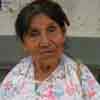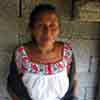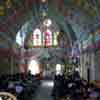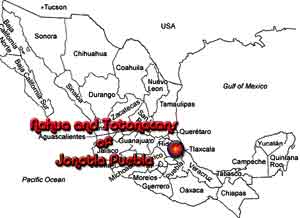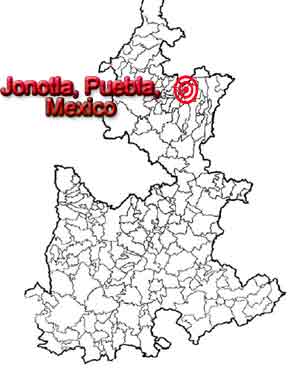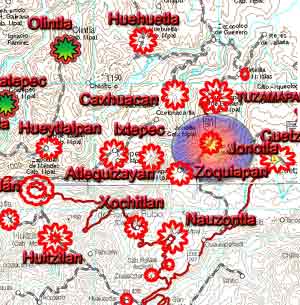 |
 |
 |
 |
|
||||||||||
 Jonotla, Puebla, Mexico was founded in 1180 by an indigenous man called Ixocelotl and three companions. The town originally had a large population of both Nahuatl and Totonacan populations at the time of the Spanish conquest. Jonotla, Puebla, Mexico was founded in 1180 by an indigenous man called Ixocelotl and three companions. The town originally had a large population of both Nahuatl and Totonacan populations at the time of the Spanish conquest.
The town gets its name from a tree called a Xonote, the sap of which is said to be medicinal, the bark is used to make ropes and nets for fishing and the wood of the tree is used to make rafts. The geography of the municipality is very rugged with peaks reaching up to 3000 feet above the river valley. There also remains of volcanic cones in the region. There are two ethnic groups in the region the most populous is the Nahua speakers followed by the Totonacan speakers. According to the 2005 census about 50% of the population speaks indigenous languages. The use of traditional costume here is confined to those above 65 years old and has been lost to the younger generations. The women wear a white blouse usually embroidered with running stitch, both groups wear a white skirt of poplin or muslin and depending on the ethnic group there are both pleats and some machines stitchery. The Totonacan women do not seem to use the very wide belt ,that is common in other Totonacan regions, but a belt very similar to those used by the Nahua's. There is a Chapel To the Virgin of Guadalupe on the highest point in the community where a miraculous image was found of the Virgin Guadalupe in 1922. On December 12 there is a large festival held at the chapel with pilgrims coming from many parts of the surrounding areas. About the chapel at the very highest point in the municipality there is a lookout and from there you can see the entire Sierra Norte of Puebla, the climb is well worth the view and the five pesos or $.50 you pay to go up. |
||||||||||
|
||||||||||
